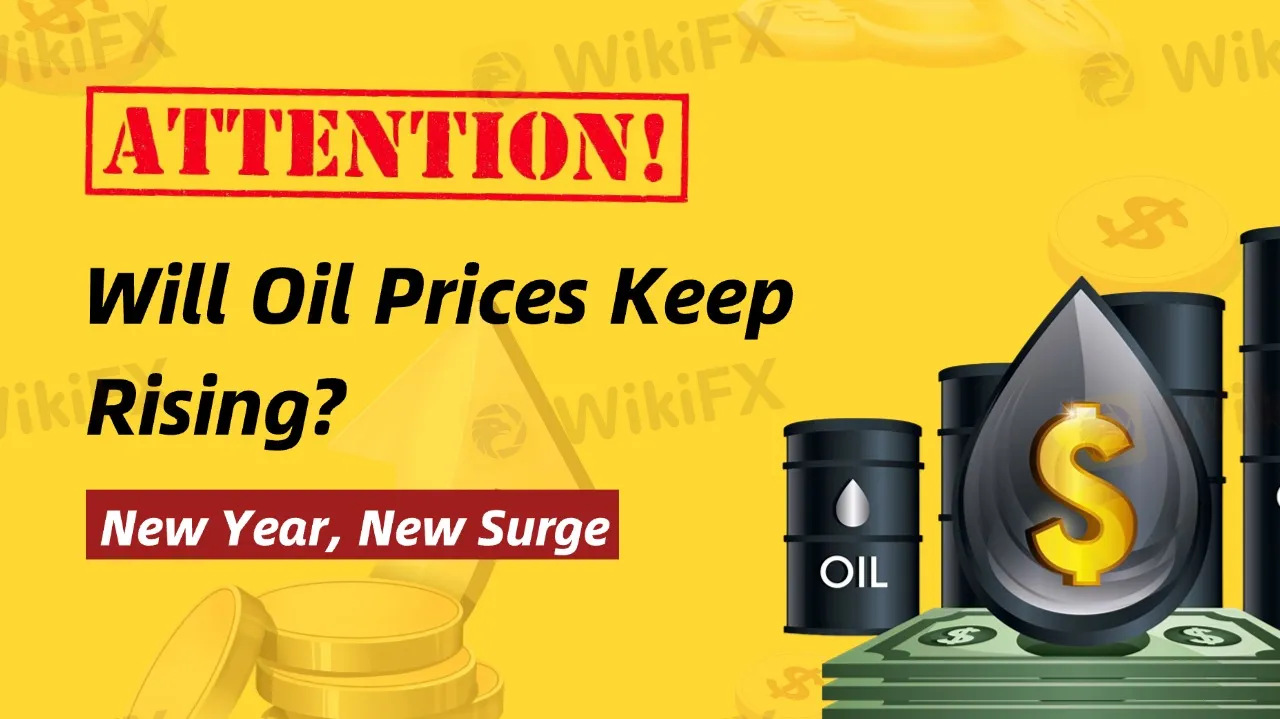简体中文
繁體中文
English
Pусский
日本語
ภาษาไทย
Tiếng Việt
Bahasa Indonesia
Español
हिन्दी
Filippiiniläinen
Français
Deutsch
Português
Türkçe
한국어
العربية
New Year, New Surge: Will Oil Prices Keep Rising?
Abstract:As of the writing of this article (January 2), oil prices stand at $71.88 per barrel. Investors need to continue monitoring whether the supply and demand dynamics will continue to push prices further up.

The outlook for crude oil supply in 2025 remains uncertain, but the short-term increase in demand has driven oil prices higher.
Oil price fluctuations are influenced by multiple factors, primarily including global supply and demand dynamics, geopolitical risks, crude oil inventory levels, and OPEC+ policies. Since the beginning of last year, OPEC+ has implemented production cuts, which have helped support oil prices.
However, between July and September, oil prices fell sharply due to a de-escalation in geopolitical risks, especially with the progress of the Israel-Palestine ceasefire talks, as well as capital market shocks that suppressed the valuations of risk assets like crude oil.
Geopolitical Influence
On the supply side, geopolitical tensions have provided some support for oil prices. If geopolitical tensions ease in 2025, this support could weaken, and oil prices may face downward risks. Investors should remain cautious about the potential for prices to drop again.
This week, attention should be focused on the EIA (U.S. Energy Information Administration) inventory data. According to the data released on December 31, U.S. oil production increased by 259,000 barrels per day in October, reaching a record high of 13.46 million barrels per day, driven by a surge in demand—the strongest since the pandemic.
The EIA forecasts that U.S. oil production will rise to a new record of 13.52 million barrels per day this year. However, some analysts believe that supply could tighten this year, particularly due to the policies of President-elect Trump, including sanctions on Iranian oil exports, which may provide short-term support for oil prices.

Impact of Fed Rate Cuts
At the same time, according to CMEs “FedWatch” tool, the probability of the Federal Reserve keeping rates unchanged in January 2025 is 88.8%, while the chance of a 25 basis point rate cut is 11.2%.
Typically, when the Federal Reserve cuts rates, the U.S. dollar depreciates, which in turn tends to push oil prices higher. Rate cuts increase market liquidity, lower borrowing costs, and stimulate economic demand, thereby driving up both oil demand and prices.
However, oil prices will still be affected by a combination of factors, including global economic conditions and geopolitical risks, so a comprehensive analysis of various dynamics is necessary.

Disclaimer:
The views in this article only represent the author's personal views, and do not constitute investment advice on this platform. This platform does not guarantee the accuracy, completeness and timeliness of the information in the article, and will not be liable for any loss caused by the use of or reliance on the information in the article.
Read more

Participate Now in ForexCup Trading Championship
FXOpen announced the trading competition called ForexCup Trading Championship 2025 for traders. You can join, trade, and compete for exciting prizes. Here are the details

What the Movie Margin Call Taught Traders About Risk and Timing
The 2011 film Margin Call offers a gripping portrayal of the early hours of the 2008 financial crisis, set within a Wall Street investment firm. While the film is a fictionalised account, its lessons resonate strongly with traders and finance professionals. For one trader, watching the film had a lasting impact, shaping how they approached risk, decision-making, and the harsh realities of the financial world.

Why More Traders Are Turning to Proprietary Firms for Success
Over the past decade, one particular avenue has gained significant popularity: proprietary trading, or prop trading. As more traders seek to maximize their earning potential while managing risk, many are turning to proprietary firms for the resources, capital, and opportunities they offer. In this article, we’ll explore why an increasing number of traders are choosing proprietary trading firms as their preferred platform for success.

Day Trading Guide: Key Considerations
How does day trading balance freedom and precision in fast-moving markets? Learn key strategies to navigate risks and seize intraday opportunities effectively.
WikiFX Broker
Latest News
Fake ‘cyber fraud online complaint’ website Exposed!
Day Trading Guide: Key Considerations
NAGA Launches CryptoX: Zero Fees, 24/7 Crypto Trading
Scam Alert: 7 Brokers You Need to Avoid
AvaTrade Launches Advanced Automated Trading Tools AvaSocial and DupliTrade
What Determines Currency Prices?
Why More Traders Are Turning to Proprietary Firms for Success
MC Markets Review 2025
How to Use an Economic Calendar in Forex Trading
T4Trade Enhances Forex Trading with Advanced Tools for 2025
Currency Calculator






